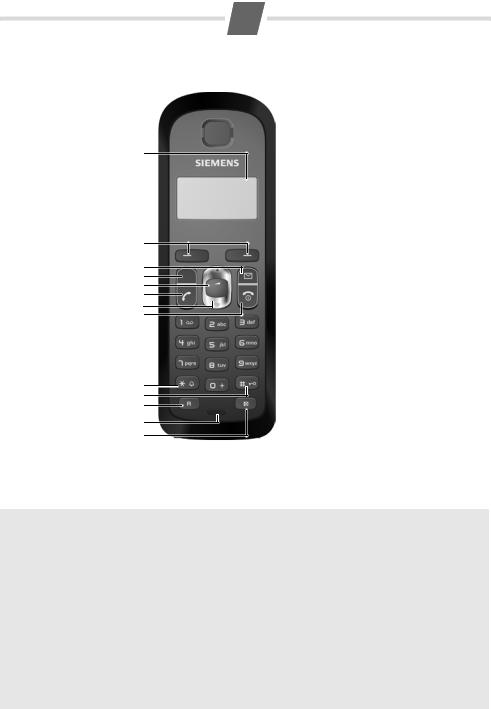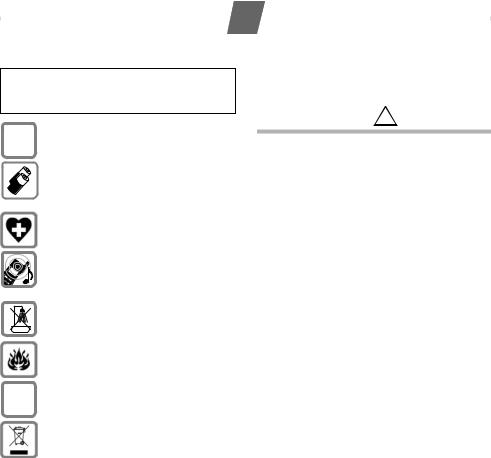Siemens GIGASET AS28H Operating Manual

1
Gigaset AS28H handset
1Charge status of the batteries
2Display keys
3Message key
Flashes: new messages received
4Handsfree key
5Control key (u)
6Talk key
7Directory key (press down)
8End call and On/Off key
9Ringer on/off (press and hold in idle status)
10Keypad lock on/off (press and hold)
11Recall key
-Consultation call (flash)
-Dialling pause (press and hold)
12Microphone
13"Microphone off" key
1
2
3
4
5
6
7
8
9
10
11
12
13
V
11.12.11:56
INT MENU
d
h
Display keys on handset:
Pressing a key launches the function that appears above that key in the display.
Display |
Function when pressed |
icon |
|
INT |
Call other registered hand- |
|
sets ¢page 7. |
MENU |
Open main/submenu (see |
|
Menu tree ¢page 10). |
“ |
Go back one menu level. |
U |
Scroll up/down or adjust |
|
volume with u. |
T |
Move cursor to left/right |
|
with u. |
˜ |
Backspace deletes one |
|
character at a time from right |
|
to left. |
OK |
Confirm menu function or |
|
save entry. |
ECO DECT
You are helping to protect the environment with your Gigaset AS28H.
Reduced energy consumption
Your telephone has a power-saving adapter plug and uses less power.
Reduced transmission power (depending on the base station)
The transmission power can only be reduced if your base station supports this function.
The transmission power of your telephone is reduced automatically:
The handset's transmission power is reduced depending on the distance to the base station.
The transmission power on the base station is reduced to virtually zero when only one handset is registered and the handset is in the base station.
You can reduce the transmission power of the handset and base station even more by using Eco Mode/ Eco Mode+. For further information, please see your phone's user guide.

|
2 |
|
|
|
|
Safety precautions |
Care |
|
Read this user guide and the safety precautions carefully before use. Explain their content and the potential hazards associated with using the telephone to your children.
Only use the mains adapter supplied.
$
Fit only the¢recommended, rechargeable batteries ( page 9), i.e. never use any other battery type or non-rechargeable batteries as this could result in significant health risks and personal injury.
The operation of medical appliances may be affected. Be aware of the technical conditions in your particular environment, e.g. doctor's surgery.
Do not hold the rear of the handset to your ear when it is ringing. Otherwise you risk serious and permanent damage to your hearing.
The handset may cause an unpleasant humming noise in hearing aids.
Do not install the phone in a bathroom or shower room. The phone is not splashproof.
Do not use your phone in environments with a potential explosion hazard, e.g. paint shops.
ƒsure you also give them the user guide.
Disposal
Batteries should not be disposed of in general household waste. Observe the local waste disposal regulations, details of which can be obtained from your local authority or the dealer you purchased the product from.
All electrical and electronic equipment must be disposed of separately from general household waste using the sites designated by local authorities.
If a product displays this symbol of a crossed-out rubbish bin, the product is subject to European Directive 2002/96/EC.
The appropriate disposal and separate collection of used equipment serve to prevent potential harm to the environment and to health. They are a precondition for the re-use and recycling of used electrical and electronic equipment.
For further information on disposing of your used equipment, please contact your local authority, your refuse collection service or the dealer you purchased the product from.If you give your Gigaset to someone else, make
Emergency¢ numbers cannot be dialled if the keypad lock ( page 1) is activated!
Not all of the functions described in this user guide are available in all countries.
Wipe the charging cradle and the handset with a damp cloth (do not use solvent) or an antistatic cloth. Never use a dry cloth. This can cause static.
Contact with liquid !
If the handset should come into contact with liquid:
Switch the handset off and remove the batteries immediately.
Allow the liquid to drain from the handset.
Pat all parts dry, then place the handset with the battery compartment open and the keypad facing down in a dry, warm place for at least 72 hours (not in a microwave, oven etc.).
Do not switch on the handset again until it is completely dry.
When it has fully dried out, you will normally be able to use it again.

Never expose the telephone to the influence of heat sources, direct sunlight or other electrical devices.
Protect your Gigaset from moisture, dust, corrosive liquids and vapours.
Connecting the charging cradle
2
1¤ Connect the flat plug from the power supply 1. ¤ Plug the mains adapter into the plug socket 2.
|
|
||
|
|
2 |
|
If you need to disconnect the plug from the charging cradle, |
|
|
|
|
|
|
|
press the release button 1 and disconnect the plug 2. |
|
|
|
1 |
|
||
